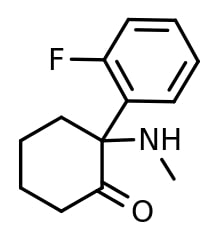2F-Ketamine, also called 2-Fluorodeschloroketamine (2-FDCK), is structurally similar to ketamine and has gained popularity recently among recreational drug users. Its effects are also similar to ketamine, with some users reporting a longer duration of action.
In this article, we’ll explore the history of 2F-Ketamine and provide a full 2F-Ketamine research chemical review. We’ll also discuss dosage information for recreational use, including the effects of different doses on the user’s experience. Additionally, we’ll explore this drug’s subjective user experiences and side effects.
By the end of this 2F-Ketamine review article, you’ll understand the drug’s benefits and potential risks, allowing you to make informed decisions about its use.
General Information on 2F-Ketamine (2-FDCK)
To begin this research chemical review, we’ll cover general information. 2F-Ketamine, known as 2-Fluorodeschloroketamine (2-FDCK) or 2F-K, is a dissociative anesthetic drug first synthesized in the late 1950s. The 2F-K research chemical derives from ketamine, a well-known anesthetic medication commonly used in human and veterinary medicine. Like ketamine, 2F-Ketamine works by blocking specific brain receptors. In turn, this leads to a dissociative state that comes with altered perception, hallucinations, and a sense of detachment.
2F-K can be snorted, smoked, or dissolved in a liquid and injected. The drug’s duration can vary depending on the dose and the person. Overall, though, effects last anywhere from 2 to 6 hours.
If you’re looking for legal highs, think twice because 2F-K isn’t permitted. While 2F-Ketamine has not been approved for use in clinical settings, it’s commonly used as a recreational drug.
History of 2F-Ketamine (2-FDCK)
2F-Ketamine was first synthesized in the late 1950s as part of a series of derivatives of ketamine. Ketamine had been developed just a few years earlier, in 1962. Soon after, ketamine became widely used in clinical settings due to its rapid onset, analgesic effects, and ability to induce a dissociative state.
2F-K was a potential replacement for ketamine but was never approved for clinical use. In fact, it remained largely unknown until the 2010s, when it began to gain popularity as a recreational drug.
Since then, 2F-K has risen in popularity. People use it at raves, clubs, and other social events. Its use has also been reported among people seeking relief from chronic pain, depression, and anxiety, although there is limited research on the efficacy of 2F-Ketamine for these purposes.
Dosage and Administration
is typically sold as a white powder or crystal. The dosage and administration vary depending on many factors. Those factors include tolerance, administration method, and desired effects.
As with any drug, it’s necessary to use 2F-Ketamine responsibly. Start with a low dose to gauge its effects. The following are general guidelines for dosages of 2F-Ketamine when used recreationally:
Low Dose: 10-30 mg
Common Dose: 30-80 mg
Strong Dose: 80-150 mg
Heavy Dose: 150+ mg
2F-Ketamine can be administered via several methods, including oral ingestion, insufflation (snorting), and injection. Injecting 2F-Ketamine is extremely dangerous and not recommended under any circumstance.
Notably, 2F-K is very potent. It has potential risks and side effects and should only be used with proper medical supervision. However, since it’s not on the list of legal drugs, that could prove difficult. Harm reduction strategies like allergy testing, testing for purity, using accurate measuring tools, and avoiding polydrug (two or more drugs at once) use, can also help to minimize risks.
User 2F-Ketamine (2-FDCK) Reviews
User experiences with 2F-Ketamine vary widely depending on the person, the dosage, and the method of administration. However, there are some general trends and patterns based on user reports and reviews.
People who used this drug report, perhaps predictably, that it produces effects that are similar to those of ketamine. Those include a dissociative state, altered perception, hallucinations, and detachment from reality. However, some users have reported the effects of 2F-K are milder and longer-lasting than those of ketamine.
Some users report relief from depression and a sense of freedom. Reflexes may be reduced as the anesthetic effects settle in. Stong doses (80-150mg) cause a strong pain tolerance and may cause strange feelings of fragmentation in the body.
Onset of Effects
The onset of effects is rapid, with peak effects occurring within 30 minutes to an hour after use. As mentioned, the effects last 2 to 6 hours. Effects include the following:
- Altered perception of time and space
- Dissociative state and sense of detachment from reality; disorientation
- Hallucinations, both visual and auditory
- Changes in mood and emotions
- Euphoria and relaxation
- Increased self-reflection
- Numbness and tingling sensations in the body
- Reduced anxiety and stress, drowsiness
- Reduced pain perception
- Visual distortion and blurring
- Changes in auditory perception (echoes and distortions)
- Increased sensitivity to light and sound
Some users report feeling a sense of euphoria, relaxation, and clear-headedness. Others report feeling confused and disoriented. Many users report changes in their perception of time and space. They may even have vivid hallucinations and mood swings.
Potential Side Effects of 2F-Ketamine (2-FDCK)
Some of the potential side effects of 2F-Ketamine based on user reports and research studies include:
- Nausea and vomiting
- Coordination and balance loss
- Dizziness
- Confusion, cognitive impairment
- Increased heart rate and blood pressure
- Difficulty breathing
- Coma or unconsciousness
- Seizures and convulsions
- Liver and kidney damage
- Addiction
The risk and severity of these side effects can vary. They depend on factors like a person’s health, the dose and frequency of use, and the administration method. Injecting 2F-Ketamine is particularly dangerous and vigorously discouraged because of the serious risks associated with intravenous drug use.
Long-term use of 2F-Ketamine can also lead to physical and psychological dependence, withdrawal symptoms, and other health consequences. As such, it’s key to use the drug responsibly. Seek professional help if you or someone you know is struggling with addiction or dependence.
Overall, while 2F-K can produce a range of subjective experiences, the risks must be taken seriously. It should only be used under a healthcare professional’s guidance or in a controlled setting with supervision. Harm reduction strategies can also help to minimize risks.


